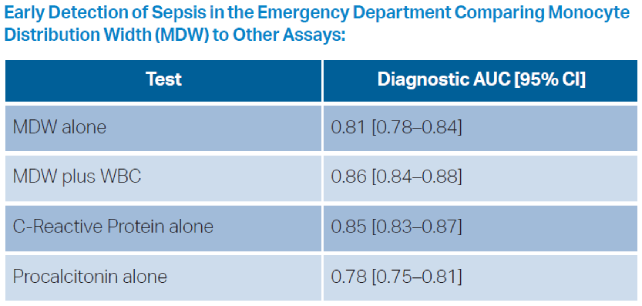
Additional proprietary biomarker assays under development, include the IntelliSep and Immunix tests. The IntelliSep test pushes samples through microfluidic channels with a camera performing image acquisition of WBCs under deformation stress.5 The behavior of WBCs under deformation stress is measured by automated methods as their primary metric, reflecting host response to infection. These properties were then correlated with clinical outcomes, as validated on a set of emergency department patients presenting with potential sepsis and a set of healthy volunteers. Similarly to other inflammatory markers, the output of the test is risk-stratification into low- and high-risk cohorts alongside an indeterminate zone.
Explore This Issue
ACEP Now: Vol 41 – No 07 – July 2022What the Studies Show
Few published studies of the IntelliSep test exist, and none include direct comparisons against other conventional markers of inflammation.6,7 Using the most conservative interpretation of published performance, the lowest-risk category demonstrated an 87.5 percent sensitivity, while the highest-risk category demonstrated an 86.2 percent specificity. The number analyzed was low enough that even small changes in sepsis outcome adjudication had dramatic effects on positive and negative likelihood ratios. To put it mildly, many data remain to be presented to evaluate both this test’s performance and its feasibility in clinical deployment.
The Immunix test is another biomarkerbased evaluation with a slightly different twist. In this instance, biomarker data is combined with electronic health record (EHR) data to produce a prediction superior to either biomarkers or EHR data in isolation.8,9 For emergency department applications, their proprietary implementation utilizes IL-6, CRP, and procalcitonin, while a hospital-wide version includes additional biomarkers and an expanded set of EHR variables. An even greater paucity of data is available to evaluate this technology for use in the emergency department. A single observational study on frozen remnant blood samples revealed an AUROC on their validation set of 0.83, with a sensitivity of 80 percent and a specificity of 70 percent at their selected optimal threshold to identify a low-risk population.10 In my opinion, this test is even further from operational consideration as it requires the added complexity of direct access to clinical information systems.
The final new test worth discussion is a biomarker marketed to differentiate bacterial and viral infections. The MeMed BV test combines CRP, tumour necrosis factor-related apoptosis-inducing ligand (TRAIL), and interferon-gamma-induced protein-10 (IP-10). Each of these biomarkers in isolation generates an AUROC around 0.60 to 0.68, and their combined characteristics are used to generate a score.11 The scores are then binned into five levels of likelihood of bacterial infection. At the extremes, the positive likelihood ratio is approximately 8.1, with a negative likelihood ratio of 0.1. However, the vast majority of scores have much lower LRs. The U.S. Food and Drug Administration approved this assay based on assessment of equivalence to procalcitonin, leading to the obvious follow-up question of whether it improves on this generally ubiquitous test.12
Pages: 1 2 3 4 | Single Page





No Responses to “Diagnosing Sepsis, the Next Generation”